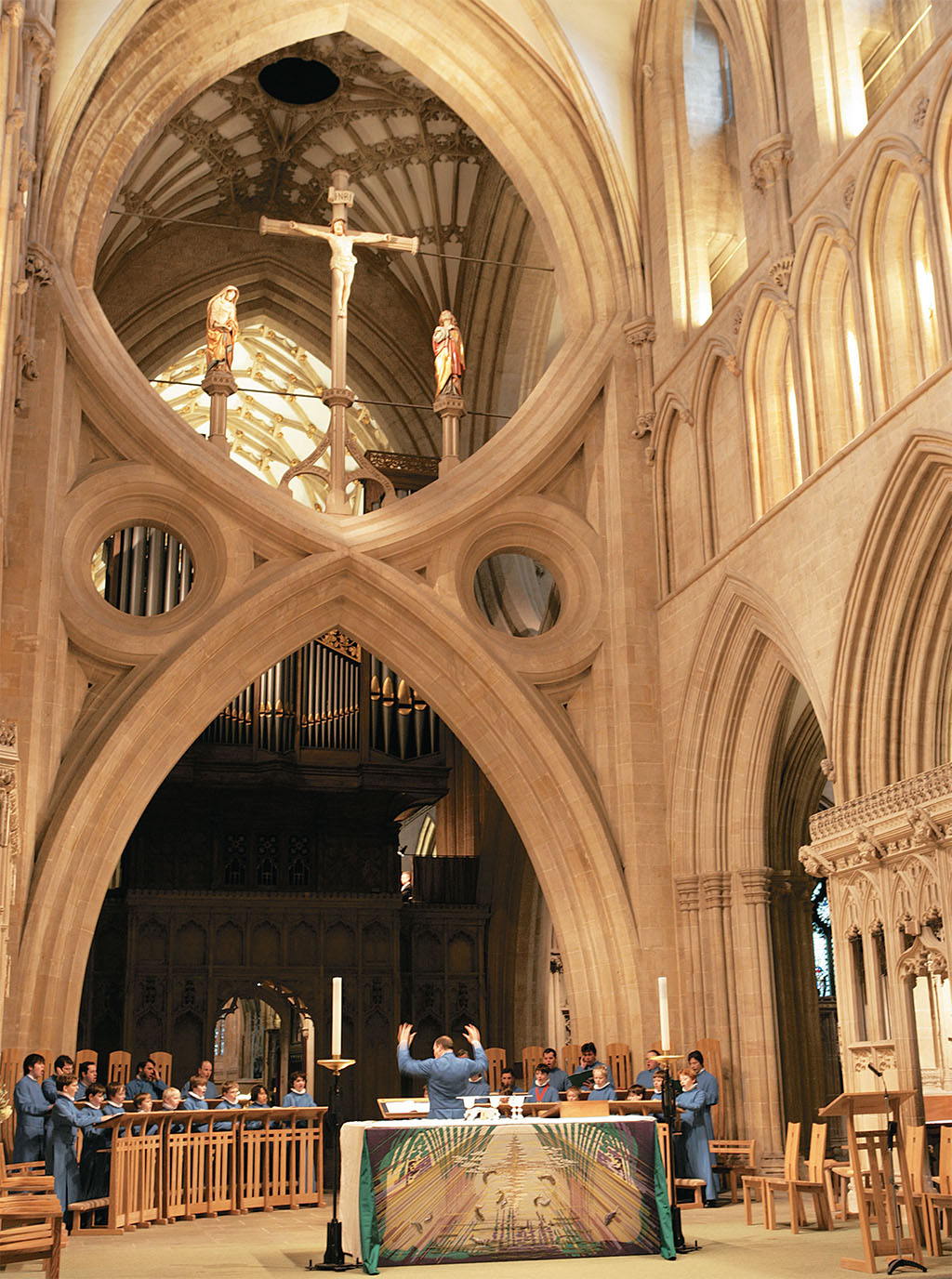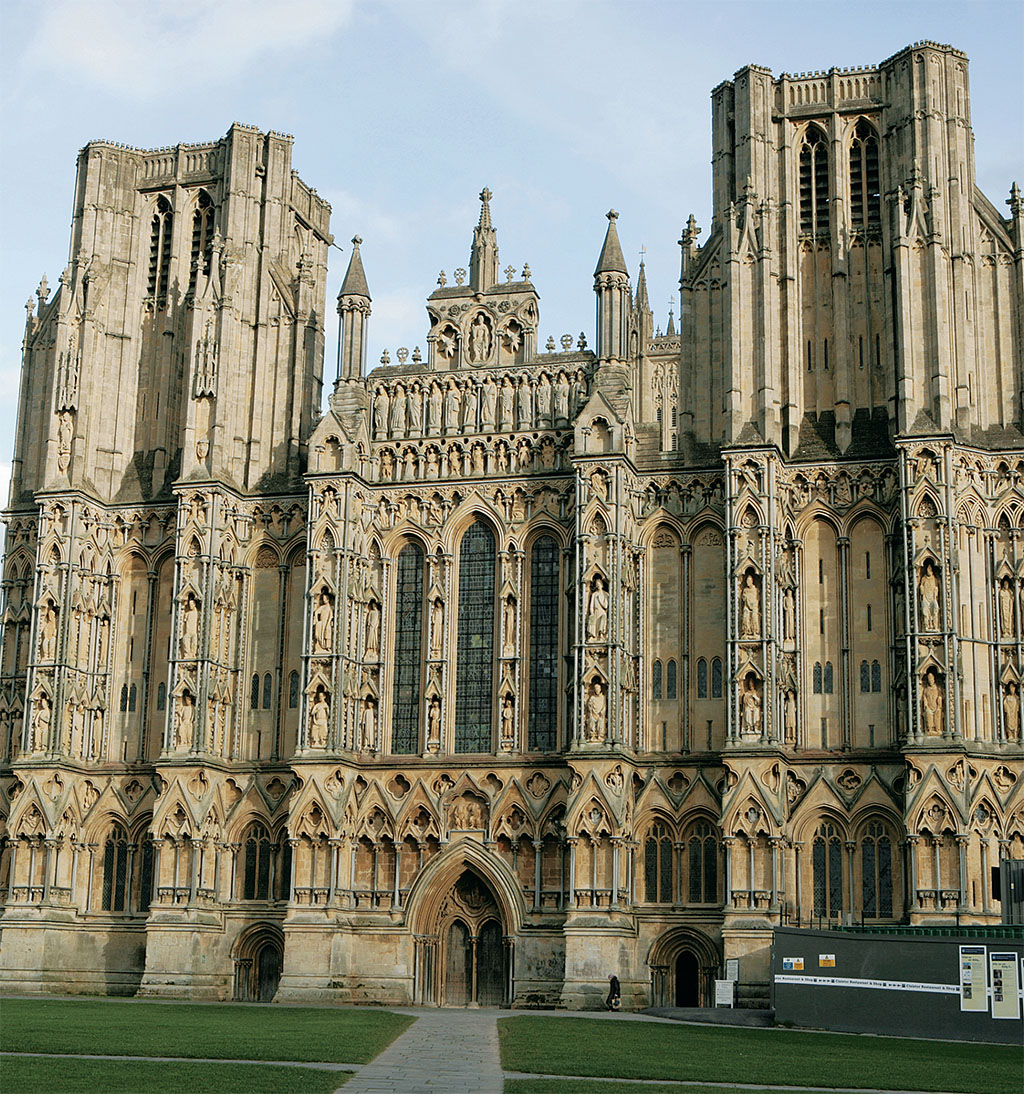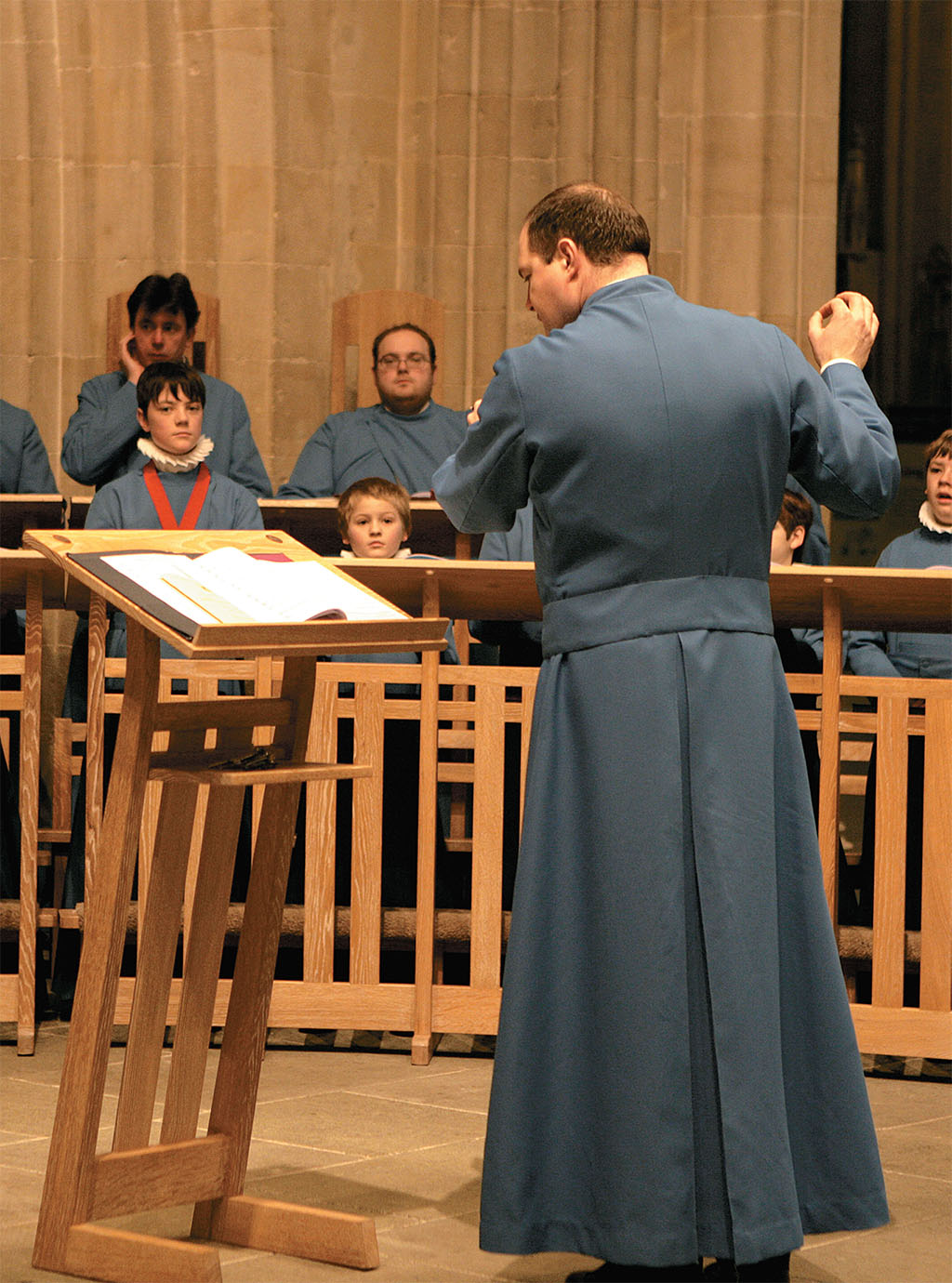
[caption id="UniqueinalltheWorldtheEnglishCathedralChoir_Feature" align="aligncenter" width="1024"]

PAUL FELIX
“THERE’S A WONDERFUL sense of community,” Iain MacLeod Jones says. “At around 4:20 p.m., as I come out of my front door and go through the garden gate, I hear the sound of 11 others in the Vicars’ Close doing the same, then we’re all trooping down to the cathedral for Evensong.”
MacLeod Jones is a tenor vicar choral with Wells Cathedral Choir—a choir of 12 men, plus 18 boy choristers and 18 girl choristers from the Wells Cathedral School. “Singing in the choir is an extraordinary musical experience,” he says. “You get such a high from quality performances and working together as a group.”
There’s no doubt that for visitors, too, choral Evensong in the 12th-century cathedral is special: listening to the voices of front row trebles and back row altos, tenors and basses shimmying heavenwards. St. Augustine enthusiastically proclaimed that, “anyone who sings, prays twice.” The spiritual lift of such occasions bears out the sentiment.
Wells in Somerset may be England’s smallest cathedral city, but its choir is among the finest in the world. There has been a choral tradition here for more than 800 years, with records of vicars choral going back to 1136. Boys sang at Wells even earlier. Vicars choral—elsewhere known as lay clerks—aren’t in Holy Orders: “Vicar” stems from “deputy,” and since the 1100s they’ve stood in to sing daily divine services on behalf of the canons.
Today there are nine vicars choral, paid a stipend by the Chapter, and three choral scholars, usually pre- or post-university young singers: all live in houses in the medieval Vicars’ Close. They sing services either with the boy or girl choristers (occasionally they all get together for larger events) and perform a wide repertoire from Renaissance masterpieces to contemporary works. Sung psalms, of course, form the powerful mainstay of daily Evensong, but on Wednesdays the men sing without choristers and range into a different repertoire, notably plainchant. Sunday services embrace sung Eucharist and sung Matins as well as Evensong—nine services per week in all.
WELLS IN SOMERSET IS ENGLAND’S SMALLEST CATHEDRAL CITY, BUT ITS CHOIR IS AMONG THE FINEST IN THE WORLD
MacLeod Jones has been at Wells for seven years, having previously sung as a choral scholar at the Roman Catholic Liverpool Metropolitan Cathedral of Christ the King, and as a lay clerk at Bristol Cathedral. “We all have jobs outside the choir, it’s impossible to survive on our stipend,” he says. “We have to find a job that fits around the hours the cathedral demands of us.” He is self-employed, chiefly as the administrator of an educational charity and as a private music teacher.
Weekdays he is in the cathedral robed and ready to rehearse by 4:30 p.m., with Evensong at 5:15 p.m. There’s a slightly longer rehearsal on Saturdays, while Sunday, the main working day, sees the choir in cathedral for rehearsals at 9 a.m. Eucharist is 9:45-11 a.m. The rest of the day alternates between brief rehearsals, Matins at 11 a.m. and Evensong at 3-4:15 p.m.
While Jones sometimes yearns for a lazy lie-in on Sunday mornings, he admits that long summer holidays, tying in with the school’s break, are sufficient compensation. “We’ve a very good voluntary choir of local people that steps in then, and Wells is also popular with touring choirs,” he says.
“A real perk of the job is to live in the beautiful 14th-century Vicars’ Close, built for us by Bishop Ralph,” Jones adds. “Before then, the vicars choral lived scattered across town. Each November, we sing an anthem at his tomb, hold a commemorative concert and special service.” After the latter, the vicars choral indulge in a time-honored commemorative breakfast featuring cheese, bread and fruitcake served on ancient pewter, all washed down by ceremonial toasts of Madeira wine. “We normally have about eight bottles between the 12 of us,” Jones admits wryly. “We’re granted Evensong off that day.”
No such indulgences for the choristers! A school for boy choristers was founded in 909, when the church of Wells became a cathedral. Today the school is independent coeducational and one of the UK’s handful of specialist music schools. Pupils, who mainly board, receive a world-class musical and academic education. Those who gain places to sing in the choir—since 1994 girl choristers have been admitted—may receive scholarships or bursaries to assist with fees.
[caption id="UniqueinalltheWorldtheEnglishCathedralChoir_img1" align="aligncenter" width="1024"]

PAUL FELIX
Boys enter the choir aged 8 or 9 (staying until 14 or voice break), girls enter between 8 and 11 (until about 16). Voice trials are held in January and June. “We are looking for someone who has that spark in the eyes, not for fully formed singers: that is what we are here for, to help and train them,” says organist and Master of the Choristers Matthew Owens. Clear voices and keenness are equally important to meet demanding commitments. The children fit in rehearsals and singing, including an hour’s practice each weekday morning, with their academic work. Boys and girls take it in turns to join the men for Evensong, requiring a 45-minute rehearsal in the afternoon. On Sundays the boys usually sing two services, the girls one.
“It is challenging but the rewards are huge,” Owens says. “Not only are the children singing some of the greatest works from medieval times to the present, they are learning all kinds of life skills, about teamwork and self-discipline. They have experiences—tours and recording CDs—that others just do not get. And they have fun.”
Some choristers go on to become choral scholars at university, lay clerks or vicars choral, or even to solo careers. A few decide their singing days are done.
In his excellent book, The English Chorister, Alan Mould refers to the heritage of choral music in liturgy as “a cultural glory unique in the world.” The tradition thrives in cathedrals and collegiate choirs from Canterbury to Truro, Durham to Gloucester. Some lay clerks are professional, some voluntary, and well over 1,000 choristers and probationers attend either dedicated cathedral/choir schools such as Wells or schools that have arrangements with the local cathedral.
The first use of song in worship is lost in the mists of time. But for the roots of England’s cathedral tradition it’s useful to pinpoint the arrival in Canterbury of St. Augustine in 597. He brought with him the Roman idea of a song school where plainsong might be taught alongside Christian learning. The concept spread rapidly. At ancient monastic foundations, the aim was to produce monks (girls also sang in nunneries). At nonmonastic cathedral foundations, schooling was a steppingstone to higher studies and a career. By the 12th century, nine of England’s 17 cathedrals were secular, including Wells, and they all had boy choristers who weren’t child oblates. Charitable almonry schools also carried forward the song school tradition.
The earliest choir singing was, broadly speaking, Gregorian chant in Latin. It was purely melodic and, as accurate notation was yet to be invented, everything had to be learned orally and memorized. There was no instrumental accompaniment and only later was the repertoire elaborated through harmony, polyphony and ornament.
RECORDS, THOUGH SCANT, PROVIDE COLORFUL glimpses of medieval song school and boarding life. Regular whippings kept discipline and there was strict religious observance of prayer and song through day and night. Boys also carried out ceremonial duties in cathedral besides singing: as cross-bearers, for example. They sometimes earned what approached a wage, though it might be difficult to extract from their master or precentor. At Wells, named purses were kept in a locked chest. The West Country school seems to have paid particular attention to dress, dormitory behavior and table manners, too: railing in the
15th century against boyish fashions of pointed slippers, long hose, strait doublets and short cassocks.
CHORISTERS OF WELLS CATHEDRAL CONTINUE AN UNBROKEN TRADITION IN CHURCH MUSIC GOING BACK TO THE 12TH CENTURY
And the music? As the Middle Ages progressed, the invention of notation, experiments in harmony, additions of newly composed text, polyphonic Mass settings, motets and embellishments of the liturgy demanded ever more vocal skill. While priests and congregation kept to simple chants and responses, choirs, incorporating virtuoso singers or soloists, tended increasingly to more complex attainments. The composition of singers that we know today—treble, alto, tenor, bass—became established. Instruments, including organs, string and wind, were introduced.
Not everyone liked such progress. John Wycliffe, arguing in the 14th century against the wider spiritual decline of a materialistic Roman Church, criticized overcomplicated choral music with its “vain tricks” and “flourishes so that no-one can hear the words.” His concern foreshadowed the ideological schism of the Church to come.
Renaissance, Reformation, the Commonwealth, Restoration: more than 100 years of theological ferment and alternating puritanical and Romanizing backlashes meant choral music in Anglican worship developed its own unique flavor.
Henry VIII’s break with Rome and establishment of the Church of England was inspired more by political expediency—his desire for divorce—than ideology. So England’s Reformation had fewer repercussions for choral singing than elsewhere. The liturgy was translated into the vernacular, and Anglican chant continued its evolution. Music, eliminated from some European churches, continued. The Dissolution swept away monasteries, but cathedrals were spared and seats of bishops such as Canterbury were re-founded as secular cathedrals. Henry had statutes drawn up for his “New Foundations” in 1539-42, which included stipulations for the size of choirs—usually a reflection of a church’s prestige—and ratio of men to boys. It’s worth noting that with the dispersal of nuns at the Dissolution, daily liturgical singing by girls (not yet part of the cathedral story) vanished until the 20th century.
A provocative overview of the reigns of Henry’s children is that Edward was on a course to abolish the Anglican choral tradition, Catholic Mary saved it and Elizabeth ensured it flourished. Certainly, under Edward’s short rule, hardliners against music in worship and other forms of “popery” gained sway. Royal Visitations to cathedrals pressed for simplified services, and with Cranmer’s Book of Common Prayer (1549) multiple daily offices were compressed into Matins and Evensong. Mass became a simplified Holy Communion.
On Edward’s death in 1553, Queen Mary dragged worship back toward Catholicism, and the Latin liturgy was heard again. Five years later, Elizabeth ushered in a tolerant middle way. A lover of ceremony, she declared that as long as a hymn “may be understanded and perceived,” then songs could be sung “in the best sort of melody and music.”
The Tudor period produced a crop of talented composers who met the diverse challenges: Thomas Tallis and Christopher Tye wrote anthems and canticles accommodating simpler English texts. William Byrd served both Catholic and Anglican interests with his powerful music. Orlando Gibbons and Thomas Tomkins carried the torch into the 17th century. The Chapel Royal, often poaching the best choristers from cathedrals across the country, was at the forefront of progress; here, verse anthems soared.
Then, near silence. The puritanical vandalism of the Commonwealth destroyed organs and music books, and disbanded choirs. Except for the singing of metrical psalms, music in church was forbidden. Let’s hasten on. The “merry monarch” Charles II, on the throne from 1660, restored cathedral services and choirs; standout composers—Henry Purcell and John Blow—wrote for the flamboyant mood of the age, witness Purcell’s “Te Deum” and “Jubilate in D.” But generally, it took cathedrals years to recover. For lack of trained trebles, they used cornets and falsettos.
The story of English cathedral choirs through the Georgian and Victorian periods to the present day has been one of decline, reform and renaissance. In the 18th century, poorly paid choirmen are reported as frequently absent, drunk or asleep during services. At Westminster Abbey as late as 1843, choirboys turned up in grubby surplices; singing was a “mechanical performance of a burthensome duty.” At Wells—no worse than anywhere—choristers kicked balls and threw stones in the nave.
BROADCASTS, CONCERTS, CDS AND TELEVISION APPEARANCES ARE JUST THE ICING ON THE CAKE, BUT THE CAKE IS WHAT WE LIVE FOR
Fortunately, the age had its saviors. Among them, Sir Frederick Ouseley (1825-89) and John Stainer (1840-1901) led improvements in training in church musicianship and performance. The eccentric Miss Maria Hackett (1783-1874), “the choristers’ friend,” spent much of her life and fortune visiting every cathedral to report on boys’ welfare and to campaign for remedy where she found neglect. It all seems a far cry from the excellence of cathedral choirs and their schools today.
Let’s return to Wells for a few last words. Here, as elsewhere, you’ll find a repertoire as broad as at any time in history, with the liturgy, embellished by superb music, central. “I keep music roughly of the same period in any one service but aim to give a broad mix within each fortnight,” says Owens. “Contemporary music is a passion of mine and we occasionally have works written especially for the choir.” These include offerings by Master of the Queen’s Music Sir Peter Maxwell Davies, Tarik O’Regan and Richard Allain. Sir Michael Tippett’s challenging canticles and pieces by Britten also get regular outings.
CHORISTER HISTORY HAS BEEN essentially male, but in recent times many cathedrals have opened their choirs to girls. Not everyone has welcomed the move, but Wells embraces the new era. Owens says: “Boys and girls usually sing separately here, which gives a greater number of children the opportunity to sing. We bring them together in the Great Choir for Christmas and concerts. I greatly enjoyed working with the mixed treble line but to mix all cathedral choirs would lose the pluralism of approach.”
He is also clear about the centrality of daily service to the choir’s raison d’être: “I make a point of saying to the choristers: broadcasts, concerts, CDs and television appearances are the icing on the cake. But there is no icing without cake. The cake is what we live on and for.”
[caption id="UniqueinalltheWorldtheEnglishCathedralChoir_img2" align="aligncenter" width="1024"]

PAUL FELIX





Comments